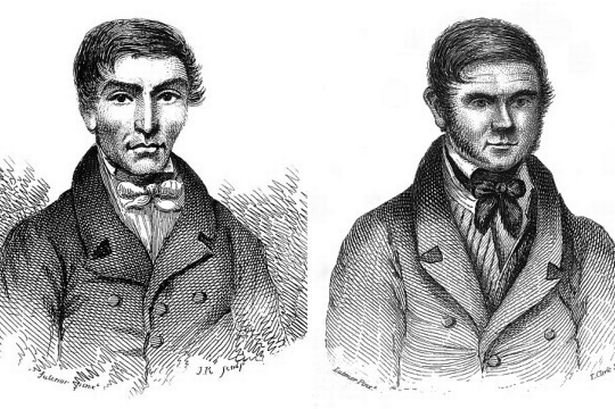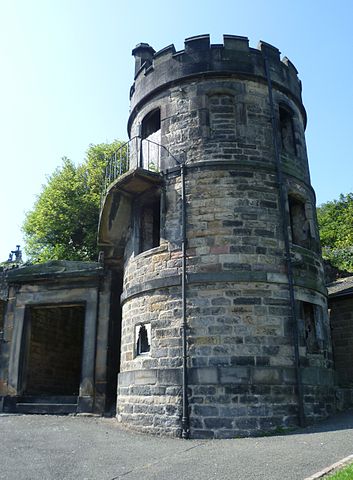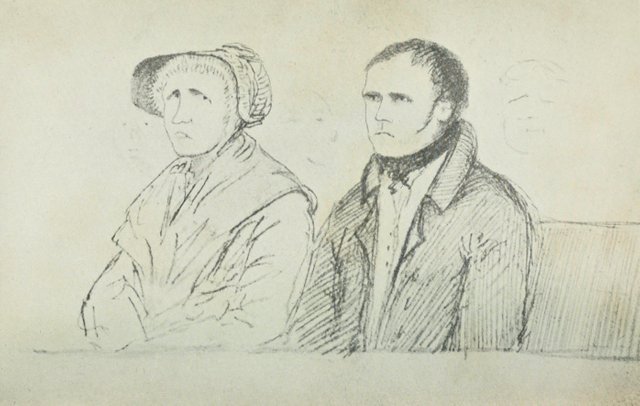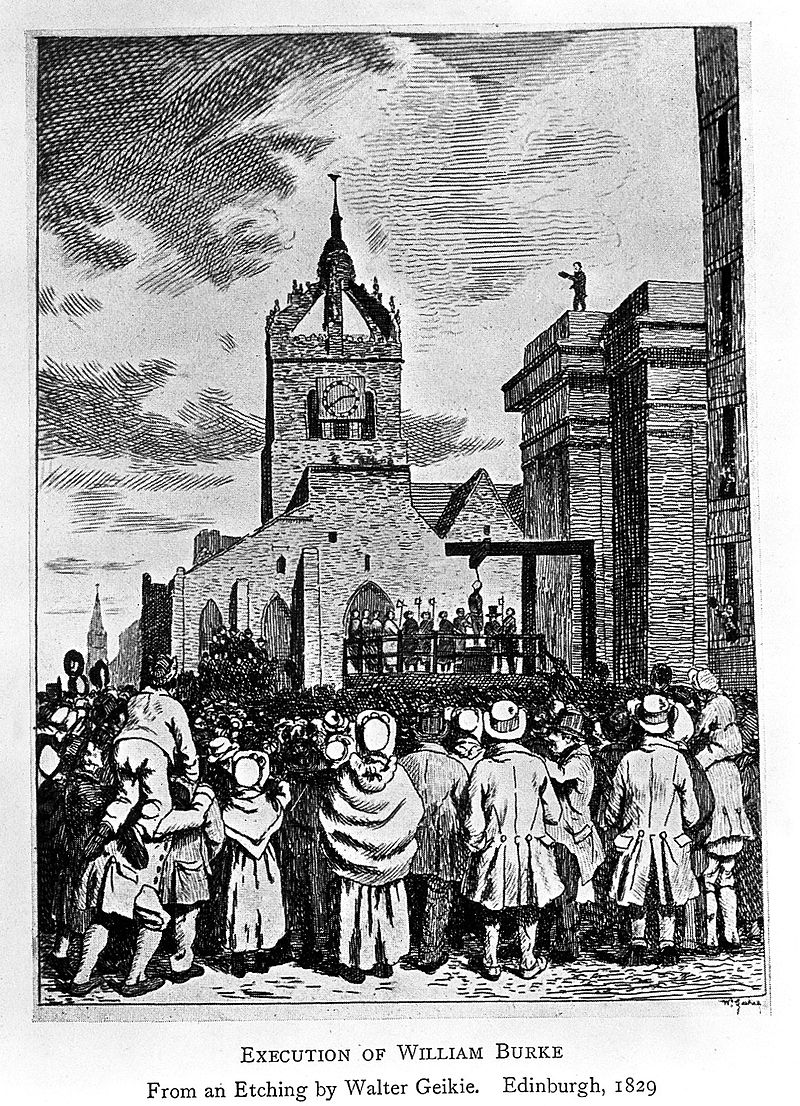Murder for Profit in the name of Medical Science. The story of Edinburgh's infamous Body Snatchers Burke and Hare

Tourists come from all over the world to see the famous Castle, visit the Museum and Art Gallery, the Royal Yacht Britannia, the statue of Greyfriars Bobby or the Scottish Parliament to name just a few of the city's many attracations.
and many are attracted to that.
There is the spectacularly spooky 'Mary King's Close' and haunted Underground Vaults beneath Blair Street, plus many other spine-tingling places of interest...
...but the story of Burke and Hare, Edinburgh’s most infamous residents, also has an allure for those wanting to explore the gory topic of body snatching or grave robbing.

Hare (left) and Burke (right)
Image public domain
William Burke and William Hare were Irish men who came to Scotland to work on the construction of the Union Canal. Burke had abandoned his wife and two children in Northern Ireland and moved in with a woman he had met in Edinburgh called Helen McDougal.
Although they both came from Ireland, it is thought that neither Burke nor Hare had met each other before. Hare lived in the same street as Burke and Helen. He had moved in with a widow called Maggie Laird and together they ran a boarding house.
In 1823, Parliament passed an act called the Judgement of Death Act. This saw the number of crimes that were punishable by death reduced dramatically. This was good news for those accused of crimes but it was bad news for the medidissecthools.
You see, in those days, medical and anatomical schools were only legally allowed to dissect the bodies of those who had been condemned to death, this led to an extreme shortage of dead bodies available to disect for medical students.
This led to the medical schools offering financial compensation for those able to get them fresh bodies and encouraged the more unscrupulous individuals who soon found a way around this shortage of bodies, leading to a wave of grave-robbing by those known as resurrectionists.
Sadly, the instances of grave-robbing became so commonplace that relatives often had to resort to watching over the recently dug graves of their dearly departed. This led to watch towers being built in cemeteries across the country.

A watchtower in Calton Graveyard in Edinburgh
Image courtesy of Kim Traynor Wikimedia
The ‘fresher’ the body, the more money the medical schools would pay for it. Therefore, it didn’t take long before the act of grave-robbing graduated to 'anatomy murder' – murder committed with the sole intention of providing the remains for medical research in exchange for financial reward.
This enterprise soon attracted the attention of Burke and Hare.
The pair’s first foray into the world of medical science happened in December 1827 when one of the tenants at Hare’s boarding house, an elderly man by the name of Old Donald, died of natural causes. The old man still owed some £4 in rent, so to cover this outstanding debt, the pair weighed his coffin down with wood before the funeral and took his body to the medical school at Edinburgh University.
There they were sent to a Professor called Robert Knox who was an prominant anatomy lecturer. Knox paid the duo seven pounds and ten shillings for old Donald’s body. They had just made a clear and relatively easy profit.
Spurred on by just how easy they had made this money, the pair struck again in early 1828 when another tenant of Hare's boarding house - a man called Joseph - became ill.
However, this time they were too impatient to wait and see if Joseph would actually die from his afflictions. Perhaps he would recover.
They didn't want to take that chance. Burke and Hare took it upon themselves to 'help' him to the afterlife. After plying Joseph with whisky, they suffocated him by covering his mouth and nose while they forcibly restrained him. This was to become their preferred method of murder as it left the body unmarked and undamaged for the medical students who would later dissect the cadavers.
In the aftermath of their killing spree, this practice become known as ‘Burking’.
With no more ill tenants, the pair decided to start luring their new victims to the lodging house. They were preying on Edinburgh’s poorest communities and seeking out those who were less likely to be missed or recognised.
In total Burke and Hare are said to have murdered at least 16 people for between seven to ten pounds a body. However, the final tally is very likely to be a much higher.
A local prostitute called Janet Brown, was lucky to escape with her life when she and her friend, Mary Patterson, were invited to stay at Burke's lodgings. Having excused herself earlier in the evening, Janet returned to find her friend missing. Hare told her that Mary and Burke had gone out for a walk. Janet waited for her friend to return but eventually decided to leave.
It was a lucky escape because her friend Mary was lying dead in the next room being prepared to be taken to Knox at the medical school. It is very likely that she herself was to be the next victim.
Encouraged by their success, Burke and Hare soon became too greedy and confident. No one in their sights was safe.
An elderly grandmother was killed with an overdose of painkillers and Hare murdered her blind young grandson by breaking the boy’s back across his knee. Even a relative of Burke's mistress Helen McDougal - a woman called Ann McDougal, was murdered in cold blood. However, with their greed came carelessness.
It all began to unravel when some of Prof Knox’s medical students were said to have recognised Mary Patterson and two other prostitutes murdered by Burke and Hare - a woman by the name of Elizabeth Halden and her daughter had made the mistake of calling at Hare's lodging house to enquire about her missing mother.
Daft Jamie
The gossip was further fueled when Burke and Hare brought in the body of a young handicapped man by the name of James Wilson. James was in his early 20's and was well known in the city as ‘Daft Jamie’.
James was a street entertainer and was well know in the Surgeons Square are of the City where he would walk around in all weather barefoot and bareheaded. This, and his often erratic behaviour, probably led to the nickname of 'Daft Jamie'.
Jamie was a well-known and popular character in the area. He never begged and his mother and sister did their best to care for him despite of his habit of roaming the streets. It was Jamie's presence within the community that made him a very poor choice of victim for Burke and Hare.
It was said that Hare's 'wife', Margaret, "who had none of Burke's practical sense of a successful murder plan," selected Jamie as he was wandering in the Grassmarket are of the city one cold and wet October day looking for his mother. His peculiar way of walking and his shoeless feet made him stand out as a potential victim.
However, when Burke and Hare had tried to 'Burke' James by plying him with whisky, James (who was tea-total) struggled firecely and so had to be killed violently by the pair. However, when Burke and Hare arrived at the medical school with the body, one of Professor Knox's colleagues, a Doctor William Ferguson, thought he recognized the corpse of the popular young man.
Jamie's disappearance had been noticed in the community almost immediately. People had reported seeing his shirt and waistcoat on strangers and they feared the worse.
Despite the growing concern, Prof Knox insisted that his newly acquired cadaver was not the body of James Wilson, but he quickly removed the head and deformed foot during the dissection of the body.
Murderous Deeds Eventually Discovered
Soon afterwards, Burke and Hare had an argument. Burke suspected that Hare and Margaret were doing deals with Prof Knox behind his back. Because of this, Burke and Helen began to take in their own lodgers.
On Halloween night, 1828 Burke and Hare’s last victim, Marjory Docherty, was invited to stay with Burke and Helen. Burke had lied to her, telling her that she was a distant relation of his mother. Burke’s other lodgers - a couple called James and Ann Gray - were invited to stay the night at Hare’s boarding house that evening so that the planned murder could take place.
On their return to Burke’s lodgings the following day, the Gray’s were told that Marjory had been asked to leave because she had become flirtatious with Burke. The Gray's then became suspicious when they were not allowed to enter the spare room where they had left their belongings.
When they were finally left alone, they discovered Marjory’s dead body hidden under the bed. The couple challenged Helen over their discovery and she offered them a bribe of £10 a week if they would keep the discovery to themselves. The Gray’s refused and reported the murder to the Police.
Word reached Burke and Hare before the Police arrived at the boarding house though, and Marjory’s body had been removed and taken to Knox. Burke and Helen, and later Hare and Margaret, were all arrested and gave conflicting accounts of what had taken place, with Burke and Hare each blaming the other.
Turning on each other
The Police investigation soon led them to Knox. James Gray identified the body found in his lecture hall as being Marjory. The murder was the lead story in the local newspaper and soon after reading about it, Janet Brown contacted the Police and identified other clothes found at Hare’s lodging house as belonging to her missing friend Mary Patterson.
However, the Police had little hard evidence to prove the crimes had been committed and eventually the Lord Advocate, offered Hare immunity from prosecution if he testified against Burke and Helen, which he readily agreed to do!
Trial and prosecution of William Burke
The trial began on Christmas Eve in 1828. On Christmas Day, William Burke and Helen McDougal were charged with the murder of Marjory Docherty. Burke was also charged with the murder of Mary Patterson and James Wilson. However, the verdict against Helen McDougal's part in the murder of Marjory was returned as ‘not proven’ under Scottish Law and she was set free. Burke, however, was sentenced to death by hanging.

Artist drawing of Burke and McDougal on trial
Public domain image
On the 28th of January 1829, William Burke was hanged at Lawnmarket in Edinburgh in front of "a boisterous, cheering crowd" of over 25,000 people. His body was then put on public display, and then, in perfect irony, his body was donated to medical science.
It is said that a number of anatomy students took ghoulish souvenirs of his skin, some using it to bind or cover books.
Burke’s skeleton is still on display at Surgeon’s Hall in Edinburgh next to his death mask and the life mask of Hare’s face.
Despite clearly being involved in the murders, Hare was released in February 1829 and went to live across the border in England. No one knows for sure what became of Hare, but it has been rumoured that he was thrown into a lime quarry by an angry mob and lived out his days as a blind beggar on the streets of London.

Public doman image
Both Helen and Margaret also fled Edinburgh, with Helen said to have emigrated to Australia and Margaret to Ireland.
Despite huge public outrage, Knox was also cleared of his involvement in the murders as Burke claimed he had no idea where the bodies had come from. However, with his reputation ruined, Knox moved to London to try to continue his career in medicine.
During my research for this article on Burke and Hare, I discovered that there were similar murders committed in the Bethnal Green area of London two years later in 1831, and that those were referred to as the 'London Burkers', so the infamy of Burke and Hare had travelled far and wide even back then.
The Burke and Hare murders and the subsequent London Burkers murders led to the Anatomy Act 1832 which allowed doctors, anatomy lecturers, and medical students greater access to bodies for medical research purposes and also allowed for the legal donation of bodies to medical science. This ended the illegal body-snatching trade.
When I was in Edinburgh last year, I happened across a graveyard that was apparently one of the areas that Burke and Hare carried out their ghoulish trade. I understand that there are guided, walking tours which take groups around the old town areas where Burke and Hare lived and carried out the murders. I think I will have a look at that sometime soon.
I also understand that Burke's skeleton is still on display at the University Medical School although I'm not sure if the public can still go in and view it though. The public were allowed in one day per month but recently the Medical School placed all its artifacts online and they can be viewed using an interactive app.
You can find more details of it here on the Edinburgh University website.
https://www.ed.ac.uk/medicine-vet-medicine/about/history/burke-and-hare
The walking tours of Edinburgh also take in Mary Kings Close and the infamous story of Deacon Brodie.
Brodie is thought to have been the true life inspiration for Robert Louis Stevenson's classic novel, 'Dr Jekyll and Mr Hyde'.
Mary King's Close is situated under the Royal Mile and well worth a visit. It is renowned for its history of the dreaded medieval plague and the "many spirits who are said to be trapped for eternity" in the undergound streets and alleyways, directly below the streets we walk on today. If you are ever in Edinburgh I would highly recommend you have a look.
If people have found this story interesting, I will write the story of Deacon Brodie and also more about Mary Kings Close and the haunted Underground Vaults in the future.
Cheers!
Dave

Congratulations @davesworld! You received a personal award!
Click here to view your Board
Congratulations @davesworld! You received a personal award!
You can view your badges on your Steem Board and compare to others on the Steem Ranking
Vote for @Steemitboard as a witness to get one more award and increased upvotes!